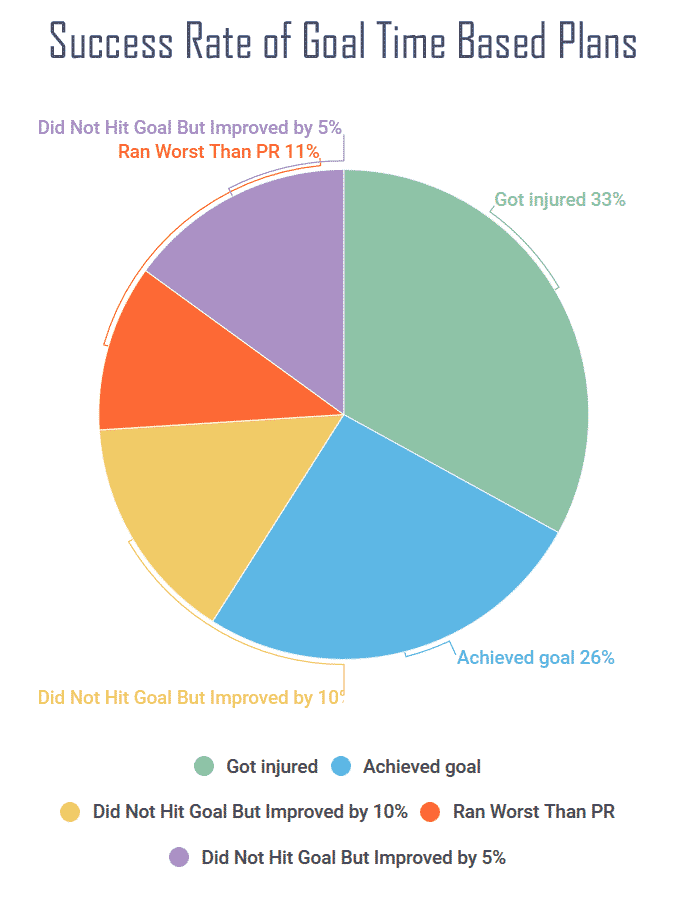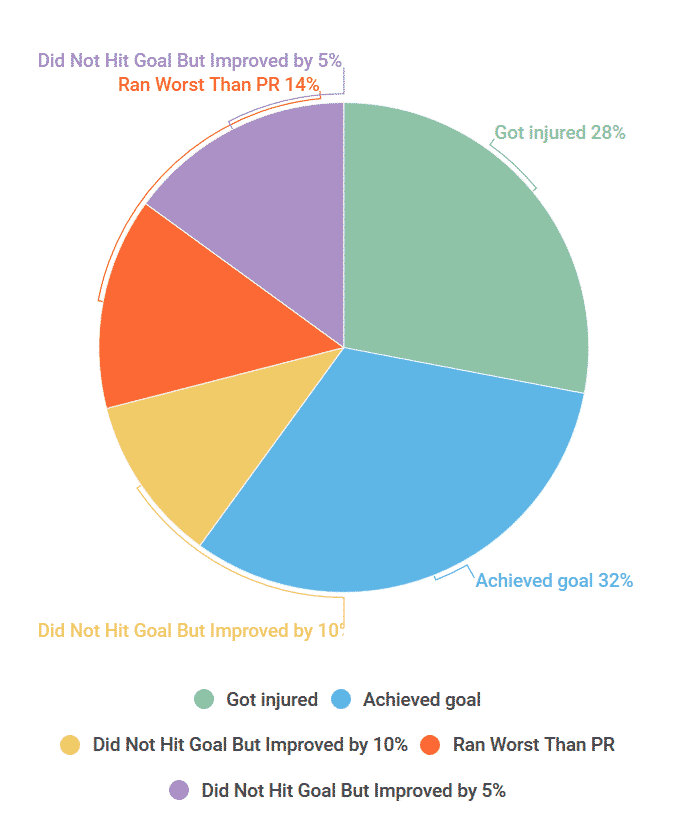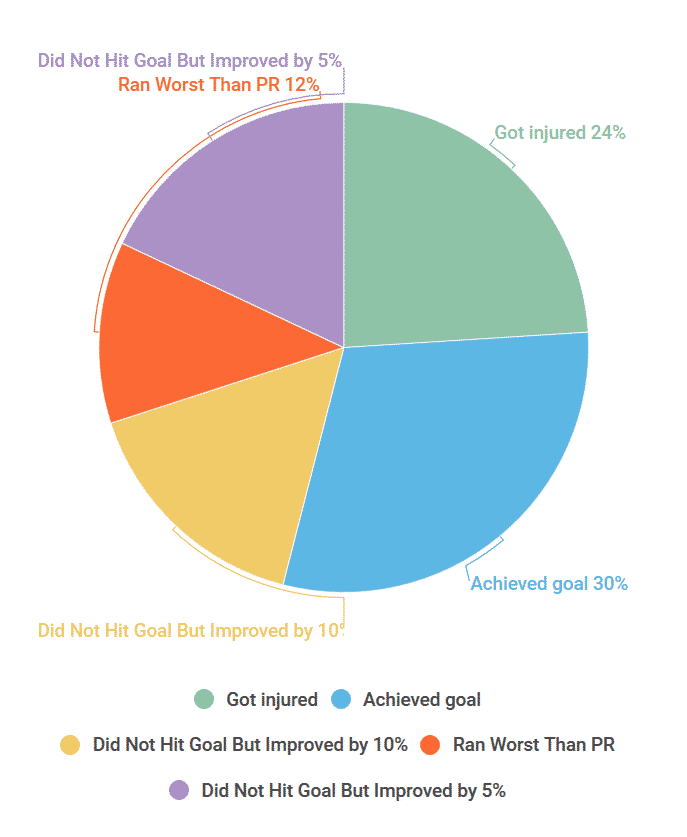Today marks a somewhat historical day in RunnersConnect.
We’ve stopped providing basic training plans – PDFs, Excel, anything that isn’t personalized; free and paid.
Why you ask? Well, we found that they just don’t work.
Last year we sent out a survey to our email list to start examining what type of training plan people were using and what the results of that plan were.
We measured “results” in terms of percentage improvement, injury rate, goal achieved and adherence.
I am going to share the specific numbers from each “type” of plan below.
Generally the results clearly showed that most basic, non-customized plans had a success rate under 45%.
Once we had collected the data, I thought long and hard about what that means for us a company that focuses on helping runners. The end decision was removing all our basic training plan options.
Now, this decision wasn’t easy. Many runners request basic training plans because maybe they can’t afford or don’t see the value in a customized plan. In our survey, many runners used basic plans because they were “simpler” and easier to find.
For us, removing them as an option will certainly hit our bottom line. It’s one of the main ways we reach new visitors to our site and introduce them to our coaches.
But, I decided that in the end, we aren’t actually helping these runners when we do this. We’re providing them the “quick fix” for what they want because it’s easy for us to do.
It’s the same concept that compels people to recommend changing shoes when talking to injured runners. It’s the simple, easy “fix” that provides instant gratification. No one wants to hear the real, guaranteed treatment that takes lots of work and weeks to see results.
That, in short, is why we’re getting rid of our basic PDF and excel based training plans.
Now, I am going to share the specific data with you from our survey and outline why I think each “type” of basic plan doesn’t work.
Goal Time Based Plans
Goal based training plans are those you’ll find that setup your training based on a specific goal. For example, Sub 3:30 marathon or Run a Sub 2 Hour Half Marathon.
The appeal of these plans is that the workouts and training paces are all geared towards hitting that particular time goal. So, in the example of the sub 3:30 plan, your marathon paced workouts would all be at sub 3:30 pace.
These plans elicit the mental leap that if you can do the workouts, you’ll hit the goal on race day.
Unfortunately, these type of plans fared the worst in our survey. Here is the data…

Why goal based plans don’t work
Not training the right systems
In my opinion, training using a plan for a specific time goal doesn’t work because it’s rarely the correct fitness level for that runner.
The workouts and the paces you are assigned in a training plan are all designed to target a specific physiological effort. For example, when you’re assigned a marathon paced run, we want to target the aerobic threshold (the fastest pace you can run while using the aerobic system as the primary energy pathway).
Now, let’s assume your “goal plan” is a 3:30 marathon. Your marathon paced run would then be right around 8:00/mile pace (or 5:00/km).
But, let’s say your fitness level or current ability is really a 3:40 marathon. Your physiological aerobic threshold is then really 8:23/mile or 5:13/km.
Therefore, when you do the workout assigned in your 3:30 training plan, you’re not actually hitting your aerobic threshold. You’re actually running much closer to half marathon pace.
Now, maybe you think running faster is just going to get you fitter overall. This might be true (if you don’t get injured first from running too hard), but it’s definitely not going to help you improve in the marathon.
This is exactly why many keep getting fitter and maybe even PRing in shorter events but bonk or fall apart during the marathon.
Increased risk of injury
You’ll also notice from the data that a significant number of respondents reported getting injured during the plan.
My theory in this is that typically, runners will choose a goal pace that is too fast. As such, the balance of hard work and recovery is thrown off, which leads to overtraining. Here’s another example to exemplify this idea:
A tempo run is designed to be a moderate or medium-effort workout. Your training plan therefore assumes that you’ll be recovered and ready to run hard again or perform a long run just a couple of days later.
However, if the tempo run was too fast for you, then the effort level was also increased. This means you won’t be as recovered for your next training session as planned. This fatigue slowly builds up throughout the weeks of marathon training until you become overtrained or your muscles, tendons, ligaments and bones give in and get injured.
Summary
In my opinion, and I think the data shows this, goal-based plans are the worst type that you could choose. The combination of incorrect workout targets and increased injury-risk make them the riskiest and least successful option.
Experience Based Plans
Perhaps the most popular type of “basic plan” is what I call the experienced based plan. These are the plans that classify runners into groups like “novice 1 or intermediate” and then tailor the mileage and workouts to gradually increase as runner moves up the experience ladder.
In theory, these plans make sense. The less experienced you are, the less mileage you’ll run and the easier your workouts will be. But, let’s take a look at the data to see if these plans actually work.

Why experienced based plans don’t work
Experience level isn’t a good measuring stick
In my years of working with runners, I’ve always struggled with the experience level question because it doesn’t really encapsulate meaningful data on its own.
What if you’ve only been running a year, but you were an active cyclist before turning to running full-time and you can easily handle 45 miles per week (70km per week)?
I bet most novice or beginner plans are going to start you off at significantly less mileage then you can handle. On the other hand, “experienced” plans with additional mileage probably include too much intensity for your new running body. Your muscles, tendons and ligaments likely aren’t ready for amount of quality/fast running assigned.
The opposite could also hold true. I know runners who have been training for years, who are very experienced, yet haven’t been healthy enough to get over 25-30 miles per week (45km per week).
Obviously, a higher mileage, more intense “experienced” plan isn’t right for them, but neither is a simplistic “beginner” program.
Summary
In the end, experience is just one factor in determining that time of training you can handle and will be optimal for you to make progress.
Your ability to handle mileage (see below), injury history, and goals should be significant factors in how your training plan is shaped.
Mileage based Training Plans
If you are insistent on using a non-customized plan, a mileage based plan is your best bet.
These plans, as the name implies, structure your training plan around a certain mileage level you’re comfortable with.
Here’s the data on how these plans performed according to our survey.

Why mileage based plans don’t work
Mileage is only one factor
Like the issue with experienced based plans, mileage gives us a good starting point, but doesn’t take into account all the intricacies of where your training is at.
It’s basically the opposite problem as the experienced based plan. Just because you’re a high mileage runner doesn’t mean you can handle the intensity or density (number of hard workouts) in a specific plan.
Likewise, as a low mileage runner, you may be capable of running more intensity because you’re running less weekly volume. Or, you could be injury-prone and need less intensity, even on a lower mileage plan.
Doesn’t address your weaknesses
I’d argue that this “flaw” of experienced based plans is inherent in all non-personalized plans, but I think it’s fitting to discuss it here.
The simple fact is no two runners are alike. Some of us are speed demons; others are aerobic monsters. Therefore, the type of training that is going to maximize our potential is going differ significantly.
This is why many runners find that a certain type of plan prepares them well for one specific distance, but not another (like having a good half marathon time, but struggling in the marathon).
What I typically find is that these types of plans work pretty well for one training cycle and maybe two, but then results stagnate. Athletes will jump to the next mileage level or try to speed up their workouts, but the race results don’t reflect the training.
When you’re not training your weaknesses, it’s very difficult to breakthrough plateaus.
In summary
Look, I’ll be the first to admit that I am biased when it comes to writing this article. But, I don’t think that makes me wrong – just maybe more critical of the flaws in these types of plans.
I also don’t begrudge coaches that write these plans and runners who use them.
I get tons of emails every day from runners looking for these types of plans – no coach should be faulted for giving someone what they want.
And, as I mentioned earlier, to runners who don’t know, these plans seem like they should be a good fit.
I also know my “data” won’t be accepted by Nature anytime soon. There’s selection bias, audience bias and a slew of other pitfalls.
However, I’ve been helping runners use these types of plans, directly and indirectly, for 10 years. The data backs up and mimics the results I’ve seen from these plans.
If you are one of those runners who are the perfect mold for whom these plans are designed for, and you like them, there’s no harm in using them.
However, if you’re struggling to breakthrough plateaus, you keep getting injured, and you’re in a rut – the answer just might be in the data and conclusions I’ve presented here.





7 Responses
This is an interesting post. I’m a new runner and am soaking up knowledge, but wanted to let you know this post was mentioned and discussed within a discussion group I’m in and several people brought up very good points regarding your lack of coverage of the results concerning runners who used a customized plan based on the factors you mention (fitness level, injury history, running endurance, etc). What were their responses for goal achievement, injury, etc. I’m sure your post and analysis will be more complete and compelling with that information (if available). Thanks for posting it and making this site available…
Great point. I am working on that post now. I just didn’t want this post to come across as too salesly. I felt that including the custom data would make it too “you need to do this” type of feel/conclusion.
Here’s the post on custom training plan data
Your data on injury rates with various plan types is very interesting. I’d be very curious to see the injury rate for custom training plans as well as no training plans for context.
I am working on that post now. Just didn’t want it to come across as too salesly
Here’s the post on custom training plan data
I certainly shared Coach Jeff’s assessment on various basic training plans.
I am an “experienced” runner running into my fifties. I have been reading various books and took on various advices from some of these books and taylored my running programs to try to meet my goals.
However after years of trying, I found myself stagnant and wasn’t moving forward. My best FM time was 6:37.
After I have signed up with RC, I still remembered vividly during my very first few training sessions whereby I did my easy pace running according to my ‘Old” habits and not the pace recommended by RC coach. One of coaches pointed the key importance of running easy at the recommended pace and the importance of improving my aerobic base.
I decide to adhere strictly to the program I subscribed and followed through all training sessions.
I completed my program without injuries and achieved a PB of 5:57 for my FM.
I think that the greatest benefit of a personalized training can do to a 56 year old runner like me.
Thanks RC coaches